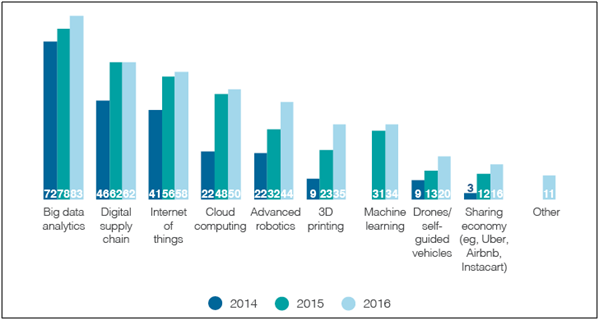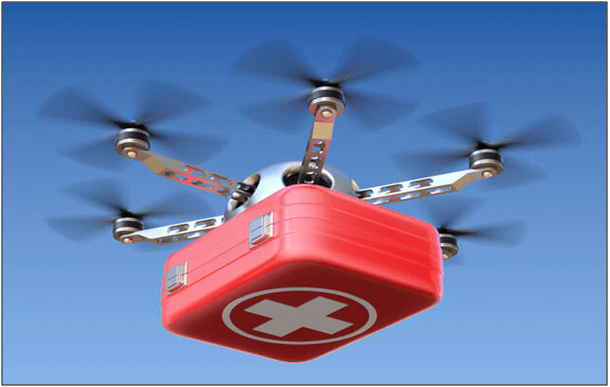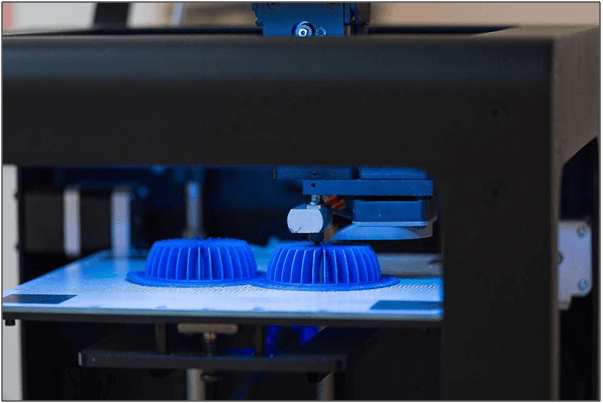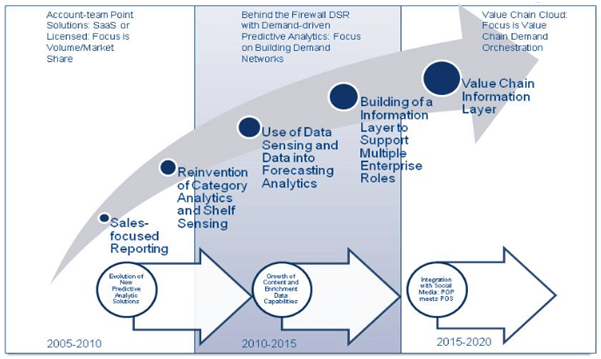In recent years, healthcare expenditure continues to rise worldwide. Healthcare supply chain account for a big portion in the expenditure represents an opportunity to reduce the cost and improve patient care efficiency. The healthcare supply chain is a vast process and disintegrated network of products and players. Managing the flow of information, supplies, equipment, and delivering services from manufacturers to patients is complex in healthcare supply chains. The alignment of the supply chain to the care delivery model and the highly-regulated nature of healthcare is creating unique challenges.
Technology plays a key role to provide advanced planning, synchronization, and collaboration. Creating an advanced technology in healthcare supply chain have been driving efficiency and help contain costs while improving quality and care.
The graph shows the trends of important technologies in the healthcare sector.

Table of Contents
IoT and RFID Tracking
Internet of Things or IoT adoption is growing in a supply chain process. IoT is a system of interrelated devices embedded with sensors, software, and connectivity to allow data transfer, integration and interact through the network without requiring human-to-human or human-to-computer interaction. GPS, RFID, UWB, WiFi and Bluetooth are common technologies within the realm of the IoT and championed within the materials handling and supply chain.
The number of devices that are going to be connected is increasing.

Asset tracking is always a daunting task in healthcare. The simple act to locate the asset can cost hours of lost productivity for staff. Healthcare sector has adopted the sensing technology such as RFID in the development of a tracking system. The RFID technology is expanding to drive accuracy and value in the healthcare supply chain. Adopting a real-time location system (RLTS) for tracking, locating and monitoring the asset. Healthcare staffs can track the real-time geographic location of equipment quickly. If equipment leaves a defined area, RTLS automatically triggers an alert. The use of RLTS in healthcare organizations is on the rise due to its precise visibility and traceability in real-time. By employing the systems, asset utilization rates improve and reduce the unnecessary purchase of extra inventory.
Automate inventory tracking with RFID smart cabinet not only streamlines in the healthcare supply chain but also improved visibility. Supplies that keep in a smart cabinet which sync with the inventory management system. The smart cabinets give a real-time inventory count, eliminate manually inventory counting, eliminate stock-out and manage inventory waste and expired items. This ensures inventory requirements are constantly met. Staff can focus on their primary role to deliver care to patients and not detract into inventory administrative task.
Drone Technology
The last-mile delivery to the customers has emerged as a critical source of opportunity for cost efficiency in the supply chain. Drones are one such technology that can have the potential and ability to provide healthcare supply chain a competitive edge in delivery vaccines, medications, supplies, and blood samples right to the source effectively and fast. Drones can assist with specializing and customizing delivery to customers especially in a remote area which lack of medical facilities. They can act as versatile courier device to assist with complicated deliveries. Instead of transporting essential medical supplies by a vehicle which take more time, the rapid delivery of medications and supplies by drones could quash outbreaks of life-threatening diseases. Using drones for delivery would reduce the cost of transportation, resulting in an affordable price for medications and supplies. To ensure patients have the supplies whenever required, healthcare organizations usually stock a lot of medicine that results in wastage when supplies expire. By using drone technology, supplies such as blood can keep in a central location and provide immediately to other locations when needed.
One of the best-known cases is Zipline from the USA. It changes the medical network through drones to deliver blood and vaccines in Rwanda since 2016. The use of the unmanned aerial vehicle in healthcare holds great promise and bring great possibilities in the healthcare industry. In the future, small indoor drones could deliver medicine to the patient bedside or home, thus free up the healthcare worker to spend more time with patients. This would result in better response time and less error in medication administrations.

3D Printing Technology
Traditionally supply chain, customers used to wait for a week for their product delivered but now with the infusion of companies such as Amazon and Alibaba, purchase decisions are made based on how fast they will receive the product. The opportunity for 3D printing rise due to the traditional supply chain constraints of the industry, the efficiencies of mass production, the need for low-cost labor, increasing of transportation costs and so on. In order to maintain a competitive edge, more and more companies have embraced 3D printing to create their products quicker.
In healthcare, 3D printing is positioned to be a great opportunity to revolutionize the medical device supply chain. 3D printing is introduced to substantively benefit the production of medical devices and the healthcare supply chain.
3D printing as one of the major disruptive trends that create its value in the printing of low volume, customer-specific and complex products within the confines of a single printer. 3D printing leverage digital profiles to print materials and create finished products in a variety of devices, such as in the production of prosthetic implants and limbs, as well as prosthetic dentistry. As a result, products can be manufactured from a 3D printer, and hence reducing the number of steps in the production chain. This technology removes the need for complex distribution networks and reduce overall logistics costs. In terms of the impact on inventory and logistics, it can be printed on demand. Hence, there is a less finished product on shelves, less wastage and inventory cost reductions.

AI and Predictive Analytics
Artificial intelligence (AI) has changed the way we manage, analyze and leverage data in the industry. As healthcare organizations develop more big data capabilities, it is time to move from basic descriptive-analytic towards predictive analytics. Predictive analytic monitor pattern and determine the likelihood of future events based on patterns in the historical and real-time data. Big data and algorithm production have reignited interest around predictive analytics. It is not just output graphs and statistics but something that’s actionable.
The diagram below shows the evolution of data over time.

In real-world, performing manual forecast and inventory management in the supply chain is a significant challenge as demand fluctuates to numerous market and macroeconomic forces. Traditional forecasting is unreliable as it cannot predict farther out with accuracy. With predictive analytics in play, healthcare organizations can leverage statistical data helped to manage the supply chain by reducing variation and gain more insights into demand patterns and supply utilization. With more accurate forecasting, the data-driven decision can be made to negotiate price, reduce demand and supply variation, and optimize inventory planning.
The full content is only visible to SIPMM members
Already a member? Please Login to continue reading.
References
Alia Paavola. (2019). “5 supply chain technologies to watch.” Retrieved from: https://www.beckershospitalreview.com/supply-chain/5-supply-chain-technologies-to-watch.html, accessed 19/06/2019.
Barry Blake. (2017). “Healthcare and the Promise of Digitization.” Retrieved from: https://www.scmworld.com/healthcare-promise-digitization/, accessed 20/06/2019.
Eddie Kek Chun Beng, ADLSM. (2019). “Digital Technology for Effective Warehousing.” Retrieved from SIPMM: https://publication.sipmm.edu.sg/digital-technology-effective-warehousing/, accessed 21/06/2019.
Elizabeth Engler Modic. (2017). “3D printing for medical, dental solutions.” Retrieved from: https://www.todaysmedicaldevelopments.com/article/additive-manufacturing-3d-medical-dental-12817/, accessed 20/06/2019
Karl Lee Ecijian, ADLSM. (2019). “Robotic Process Automation (RFA) for Digital Warehousing.” Retrieved from SIPMM: https://publication.sipmm.edu.sg/robotic-process-automation-rpa-digital-warehousing/, accessed 23/06/2019.
Michelle Lee Ean Wei, ADPSM. (2019). “New Technologies that will Impact Future Supply Chains.” Retrieved from SIPMM: https://publication.sipmm.edu.sg/new-technologies-impact-future-supply-chains/, accessed 21/06/2019.
VeenaTripathi. (2017). “Internet of Things: Opportunity and Security Issue”, International Journal of Emerging Technologies in Engineering Research (IJETER), 5 (10).

